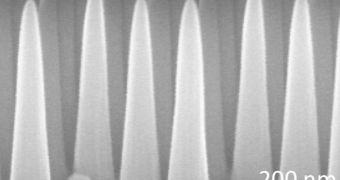Scientists at the Cambridge-based Massachusetts Institute of Technology (MIT) develop a new type of glass that eliminates glare, is capable of cleaning itself, does not get wet, and does not allow fogging to occur. Researchers basically managed to eliminate light reflections from glass.
The video embedded below shows how water droplets that fall onto the new material bounce right off it, carrying whatever impurities lie on its surface as well. The coating covering the glass has is hydrophobic, meaning that it does not attract or hold water.
The key to producing this material was the development of special nanoscale textures that have arrays of cone-shaped features. These tiny structures prevent water droplets from clinging on to the surface, but they also prevent the glass from fogging.
Researchers say that they can think of many practical applications for the new material, including the development of screens for electronic devices, advanced solar panels and vehicle windshields, and improved windows for homes and office buildings.
Details of the nanoscale texture were published in the latest issue of the esteemed scientific journal ACS Nano, which is edited by the American Chemical Society. The paper reveals that solar panel efficiency could be improved by up to 40 percent using the new glass.
Additional improvements would also be possible, since more photons will be allowed to pass through this material, because of its lack of reflections. The advantages on solar panels would therefore be two-fold, the team explains.
Mechanical engineering graduate students Kyoo-Chul Park and Hyungryul Cho, researcher Chih-Hao Chang, chemical engineering professor Robert Cohen, and mechanical engineering professors Gareth McKinley and George Barbastathis, all at MIT, were co-authors on the research paper.
Using a standard coating and etching technique from the semiconductor industry, the MIT group was able to develop a new fabrication technology for the surface pattern. Their coating consists of nanoscale cones that are 1,000 nanometers tall and 200 nanometers wide.
This 5:1 ratio is essential, if the material is to work the way researchers intend it to.
Lotus leaves and desert-beetle carapaces were some of the natural sources of inspiration the team turned to for guidance in developing this coating.

 14 DAY TRIAL //
14 DAY TRIAL //